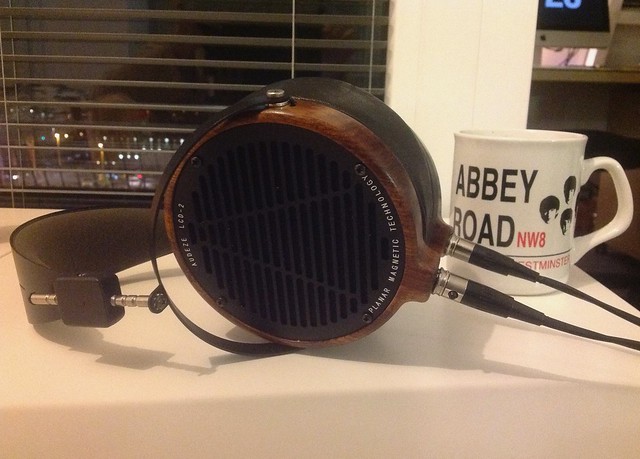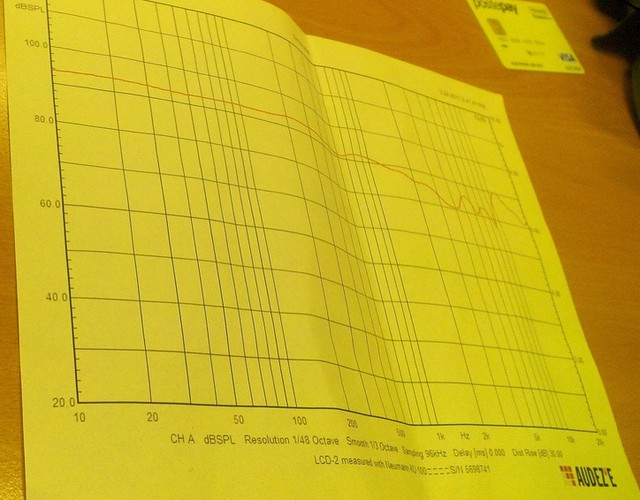The Audeze LCD-2/3 is a controversial headphone line. People having listened to them tend to group into three categories: those who consider them “forward” and “intimate”; those who consider them “recessed and clinical”. Others who call them just dark.
Certain people blame this perceived variability on the “poor quality control”; in fact, Aude’ze itself mentioned such quality control issues in many of their LCD-2 production batches.
I don’t think the variability of the headphone is so wild as certain Aude’ze fans make it to be, basing it upon QC issues. This short review aims to make some clarity about the topic.
Presentation
The LCD2 are orthodynamic headphones. Such “orthodynamic” transducers share similar planar technology adopted by electrostatic headphones (vibration propagates on same plane of the diaphragm, as opposed to dynamic transducers, where vibration takes place on the perpendicular axis), but are driven with “regular” dynamic amps. Generally, the gains over dynamic headphones consist in resolution (also called the “speed” of a diaphragm), and, typically, upper frequency smoothness; a typical advantage over certain electrostatic models, by contrast, is that the thicker diaphragm of an “ortho” can produce heavier bass more easily. On the other hand, ortho’s cannot match the same resolving capabilities of electrostatic headphones, and the ultimate perception offered by ‘stats of sound not coming from a headphone.
Structurally, the LCD-2 are open back headphones; by design they have user-replaceable cable. As shown by the picture, they have beautiful wooden cups. Although some people consider them heavy, I find them to be very comfortable and easy to wear for lengthy listening sessions.

Sound
Personally, while appreciating their technical capabilities, I didn’t like how the LCD-2 have been colouring music in my setups. I have tried a few sources I had at hand (stock Museatex Bitstream, Yulong DAH-1, Burson), and two solid state amplifier. The amp I have been using mainly has been the Cavalli Audio CKKIII. The CKKIII is a DIY solid state design, offering similar performance level as another DIY circuit, the Dynalo (commercially known as Gilmore Lite). It’s particularly suited in driving low impedance headphones.
I have also done some short listening with Burson HA-160DS, which I had on loan around Easter 2012 period.
Based on several findings, described below, I think the LCD-2 could be brought to sound a bit differently (hopefully better) with some high quality DHT amplifier, nameley stuff like Eddie Current Balancing Act, or Apex Pinnacle (or DIY amplifiers of comparable level); these would add lushness before the signal goes into the LCD-2.
Although a system could be built to take better advantage of the LCD-2 technical qualities, I feel the tests I have done, allow me to sufficiently describe the headphone’s inherent character.
I am among the people who consider the headphone to be “clinical”, and tonally imprecise. Its clinical “qualities” come from a very recessed upper midrange, associated to an enhanced upper treble response.
Its response gives exaggerates the sense of “shining” at the upper treble: while not sibilant (the listener doesn’t feel ‘scratched’ by singers overpronouncing “Ssss”, “T”, “Tch”), cymbals and similar instruments/notes have an excessive sense of glare, which also contributes to the headphone’s sense of hyper resolution, air and imaging): the highs are exaggerated in the “painless” region, after 10 kHz.
The bass is one of the most praised qualities with the LCD-2: it’s thunderous, very reactive; extremely deep, powerful, vibrating. In the right moments, all the positive qualities apply. It does manage to be visceral.
People on forums got used to call the LCD-2 bass “ruler flat”, having taken inspiration by looking at the frequency response graphs initially released with each headphone.
I can agree to an extent, but the overall frequency response isn’t ruler flat. The bass to midrange balance is wrong, and the bass quantity, beacuse of this reason, becomes excessive in the reproduction.
If listening to some rock or metal, for example, one immediately realizes that the bassist “sounds” like if he’s a much closer to the listener compared to the other members of the band: this spoils the spirit of the song.
Such wrong bass-player proximity occurs too frequently, hence it must be considered a fault of the LCD-2 colouraton.
Unfortunately, given such trade off, my personal opinion would be to take a better balance and more midrange, rather than such impressive and visceral bass.
The midrange sounds empty and vocals emotionless. If the midrange was more present, the aforementioned bass reponse would add up in most situations; the same stands true for the overly exaggerated highest frequencies. Given the U-shaped reponse, unfortunately, the bass + high dominance makes for the tonality I have called “clinical”.
If taking the LCD-2 as “raw material”, one must accept to deal with this faulty midrange balance in order to fix it as much as possible.
Eventually, I sold the LCD-2 to a friend in Slovenia, Viktor. He does love them. He also bought my CKKIII and, curiously, used to own a Burson HA160 himself. His findings mirror mine, as the Burson, which I consider better suited for dry sounding and high impedance headphones (AKG headphones being the main example), makes the LCD-2 sound much cloudier than the CKKIII, hence, dark without the same treble energy.
While I found it harder to express a preference between the two amps, Viktor prefers the CKKIII by a long margin.
To make this review useful to a potential buyer, my thinking follows: If having to decide upon the LCD2 (being for its impressive bass response, its very high resolution, and its clear and airy soundstage), I’d try to choose a midrangey DAC (like the Eximus DP-1 or the Museatex Idat-44, Bidat, or Idat-44 Mobile upgraded with Blackgates), in order to focus the system behind the Aude’ze towards midrange sweetness, without emphasizing the frequency extremes.
In particular, the Eximus DP-1 has also a pretty midcentric sounding amplifier, which I believe would be very well suited for Aude’ze headphones.
As already mentioned, other amplifier suggestions would be directed towards a high end DHT amplifier, focusing towards lushness, wamth and softness without having remotely to give up resolution and bass control.
Additional Thoughts
I’d like to mention the distinction between LCD-2 “Rev1” and “Rev2”: while it hasn’t been my direct experience (my used pair was produced in Spring 2010, right in between the supposed production change, which took place in June 2010), some people started calling the two variations as “bass light” and “bass heavy”… not having direct experience with the topic, I would rather take the words of a very reputable Head-fi’er, n3rdling, who once looked at it the other way around, by stating something like “treble light vs treble heavy”, where the Rev2 have increased treble quantity: by any comment regarding the LCD-2, I seriously doubt any existing LCD-2 could be called “bass light”.
As to another personal finding, I think expensive recables are a total waste with LCD-2. Perhaps it was just the Norse 8-conductor recable I had used, but it managed to make the sound blurrier and fatter, without any additional benefit.
As pretty as such an aftermarket cable looks, the cost of recabling isn’t justified by its performance.
If I had to concentrate over cables, I’d rather be picky over digital and analogue interconnects (or even power cords).



